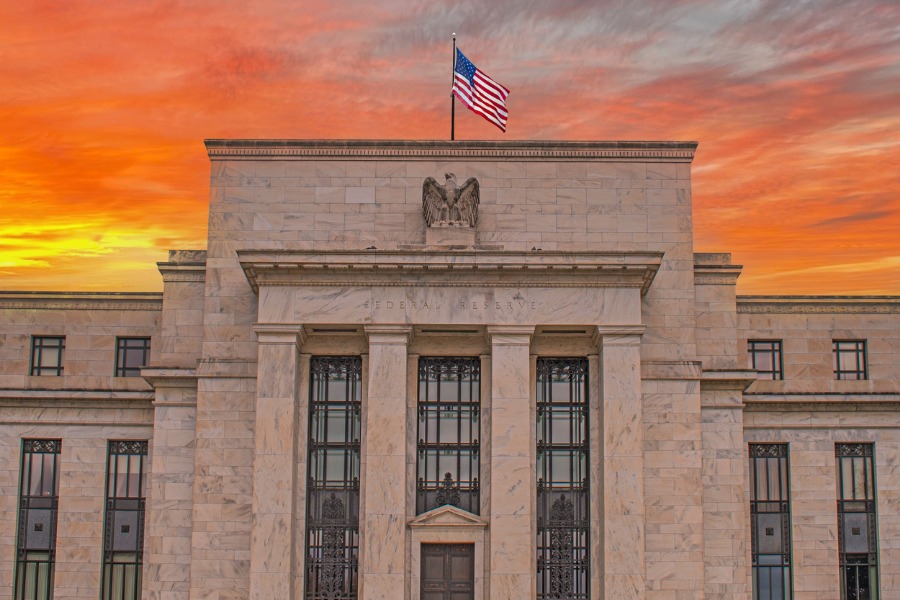

The Federal Reserve is a hot topic this week for global investors trying to time interest-rate cuts. It’s also — unusually — a prominent feature on Corporate America’s post-earnings conference calls.
As data flash mixed signals about US growth, market participants are struggling to figure out the path for Fed rate cuts beyond the September meeting. US policymakers face pressure to unwind elevated rates even as inflation holds above pre-pandemic levels and threatens to stifle consumer spending.
The words “Federal Reserve” were on track to be mentioned about 380 times on second-quarter calls with analysts, according to a Bloomberg analysis of transcripts of S&P 500 and Stoxx 600 companies. That would be the highest tally ever in the database’s records going back to 2001, if the current pace holds.
The central bank’s impact on economic growth is “a huge factor” for Corporate America right now, said Neil Birrell, chief investment officer at Premier Miton Investors.
“It might be they’re just noticing the early signs of a consumer slowdown and what purchasing managers are doing, and they could be giving the Fed a nudge,” Birrell said. “If we don’t get a rate cut soon, the balance of risks will shift from escaping inflation to avoiding an economic slowdown.”
In a statement on Wednesday, Fed Chair Jerome Powell signaled central bank officials are on course to cut interest rates in September unless inflation progress stalls, citing risks of further labor-market weakening. Policymakers held the federal funds rate in a range of 5.25% to 5.5%, a level they have maintained since last July.
In an example of just how crucial the Fed has become for consumer behavior, homebuilder PulteGroup Inc. flagged that it expects to deliver more lower-margin houses in the second half of the year as higher rates impact affordability.
In another sign of hard times, McDonald’s found its $5 meal deals have been more popular than it anticipated.
“To the degree that the Fed actually cuts interest rates in the coming months, that will provide a powerful tailwind, both financially and psychologically, as we enter 2025,” Ryan Marshall, PulteGroup’s chief executive officer, said on the call with analysts.
Over at trucking company Old Dominion Freight Line Inc., Chief Financial Officer Adam Satterfield said “seeing some” interest-rate cuts from the Fed “would certainly help from a business standpoint.” The company, along with peers, has been hurt by a drop in freight rates following the Covid pandemic.
The last time mentions of the Fed on conference calls hit a peak was in late 2022, after the central bank began the sharpest rate-hiking cycle since the 1980s, raising worries that economic growth would stall. While US corporate earnings did decline in the following quarters, the profit recession proved short-lived as consumers were able to stomach price increases.
This time around, inflation has cooled from highs but remains above the Fed’s 2% target. The labor market is slowing and the US manufacturing sector slipped back into contraction in July. On the flip side, the services sector grew by the most since March 2022, while consumer confidence is improving.
On the earnings front, a Citigroup Inc. index shows analysts are turning more bearish as the season progresses, with profit downgrades outpacing upgrades in both the US and Europe since late June.
Trends in sales growth are also worrying. About 47% of S&P 500 firms have beaten revenue expectations so far, the smallest share in five years, figures compiled by Bloomberg Intelligence showed. That’s raising concern that consumers shouldering higher prices may be at their limits.
“We knew this Fed hiking cycle was not equal for everyone, but the weaker parts are now falling,” said Manish Kabra, head of US equity strategy at Societe Generale SA. “It’s those parts that are more consumer-driven and they’re screaming that the Fed should cut rates.”

Chasing productivity is one thing, but when you're cutting corners, missing details, and making mistakes, it's time to take a step back.

It is not clear how many employees will be affected, but none of the private partnership’s 20,000 financial advisors will see their jobs at risk.

The historic summer sitting saw a roughly two-thirds pass rate, with most CFP hopefuls falling in the under-40 age group.

"The greed and deception of this Ponzi scheme has resulted in the same way they have throughout history," said Daniel Brubaker, U.S. Postal Inspection Service inspector in charge.

Elsewhere, an advisor formerly with a Commonwealth affiliate firm is launching her own independent practice with an Osaic OSJ.
Stan Gregor, Chairman & CEO of Summit Financial Holdings, explores how RIAs can meet growing demand for family office-style services among mass affluent clients through tax-first planning, technology, and collaboration—positioning firms for long-term success
Chris Vizzi, Co-Founder & Partner of South Coast Investment Advisors, LLC, shares how 2025 estate tax changes—$13.99M per person—offer more than tax savings. Learn how to pass on purpose, values, and vision to unite generations and give wealth lasting meaning
